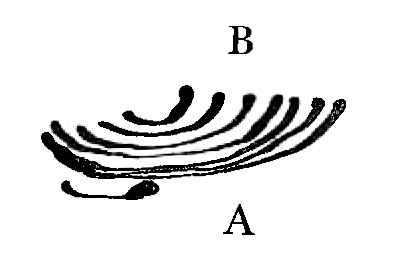My dear Sir,
I have left home for a little change and your kind letter has followed me.—3 You think far too highly of my paper on Linum etc.4 I agree that subject is only beginning. I write now partly to say that I am convinced (but evidence too long) that graduated length of stamens in same flower has no relation to powers of fertilization, at least in most cases.

For scarlet dwarf Pelargonium, if B represents the ordinary graduated stamens, you will find occasionally an additional and abnormal stamen (A) on opposite and lower side of flower. Now the pollen of this one occasional short stamen, I think, very likely would produce dwarf plants.— If you experiment on Pelargonium, I would suggest your looking out for this single stamen.5
I observed fluctuations in length of pistil in Phloxes, but thought it was mere variability.6
If you could raise a bed of seedling Phloxes of any species except P. Drummondii it would be highly desirable to see if two Forms are presented; and I should be very grateful for information and flowers for inspection. I cannot remember, but I know that I had some reason to look after Phloxes.—7
I am very glad to hear that you intend working at Linum.8
I do not know whether you have used microscopes much yet. It adds immensely to interest of all such work as ours, and is indeed indispensable for much work.— Experience, however, has fully convinced me that the use of the Compounds without the simple microscope is absolutely injurious to progress of Natural History (excepting, of course, with Infusoria).9 I have, as yet, found no exception to the rule, that when a man has told me he works with Compounds alone, his work is valueless.
With my best thanks. | My dear Sir, | Yours very faithfully. | C. Darwin.
Please cite as “DCP-LETT-4136,” in Ɛpsilon: The Charles Darwin Collection accessed on